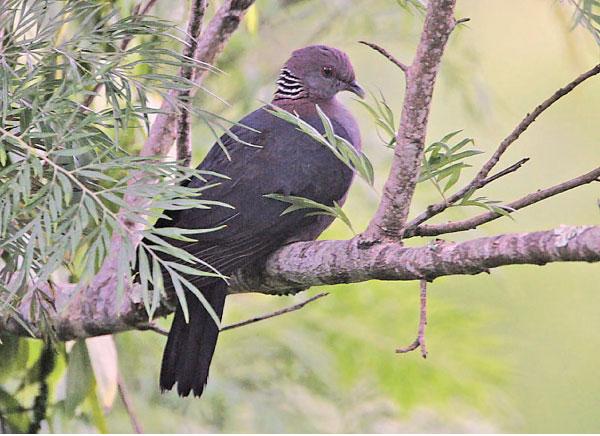
Wood pigeon
The Sri Lanka wood pigeon (Columba torringtoniae) is a pigeon which is an endemic resident breeding bird in the mountains of Sri Lanka.
This species nests in damp evergreen woodlands in the central highlands, building a stick nest on a tree and laying a single white egg. Its flight is quick, with regular beats and an occasional sharp flick of the wings which are characteristic of pigeons in general. Most of its food are vegetables. Normally silent it utters an owl-like hoo call during the breeding season.
The Sri Lanka wood pigeon is around 36 cm in length. Its upper parts and tail are dark grey, and the head and underparts are lilac, becoming paler on the belly. There is a black-and-white chessboard pattern on the nape.
This pigeon can be quite easily seen in the woods of the Horton Plains National Park.
In Sri Lanka, this bird is known as Manila Goya in Sinhala Language.
Yellow-eared bulbul

T he yellow-eared bulbul (Pycnonotus penicillatus) is a species of songbird in the bulbul family of passerine birds. It is an endemic resident breeder in the highlands of Sri Lanka. The common name is also used as an alternate name for the yellow-throated bulbul. The yellow-eared bulbul was formerly classified in the monotypic genus Kelaartia, named after Dr. E.F. Kelaart. Alternate names for the yellow-eared bulbul include the Ceylon bulbul, Sri Lanka bulbul and yellow-tufted bulbul.
The yellow eared-bulbul is endemic to Sri Lanka and is the least common of the bulbuls found in Sri Lanka. This is a bird of jungle and wooded farmland. Despite its restricted range, it is quite readily found at sites such as Horton Plains and Victoria Park in Nuwara Eliya and has been frequently sighted in rocky hills.
The yellow-eared bulbul is about 20 cm (7.9 in) in length, with a long tail. It has olive upper parts and yellowish underparts. The crown of the head is grey, and there are yellow ear tufts and a yellow patch below the eye. There is a white tuft in front of the eye and the throat is also white. Sexes are similar in plumage, but young birds are duller than adults. Their flight is bouncing and woodpecker-like. Yellow-eared bulbuls build their nests in bushes with two eggs in a typical clutch. They feed on fruit and insects.
The yellow-eared bulbul appears on 10 rupee Sri Lankan postage stamps and can also be seen on the new Rs. 5000 currency note of Sri Lanka.
Yellow-fronted barbet

The yellow-fronted barbet (Psilopogon flavifrons) is an Asian barbet which is an endemic resident breeder in Sri Lanka. Barbets and toucans are a group of near passerine birds with a worldwide tropical distribution. The barbets get their name from the bristles which fringe their heavy bills.
Yellow-fronted barbet is an arboreal species of forests and other woodland, including large gardens, which mainly eats small fruits and rarely insects. It nests in a tree hole, laying 2-3 eggs.
This is a medium-sized barbet at 21 cm. It is a plump bird, with a short neck, large head and short tail. The adult yellow-fronted barbet has a mainly green body and wing plumage, with a scaly appearance to the breast. It has a blue face and throat, and a yellow crown and moustachial stripes.
The call is a rolling kow-kow-kow-kow.
In Sri Lanka, this bird is known as mukalang kottoruwa in Sinhala language. Yellow-fronted barbet appears on a 5 rupee Sri Lankan postal stamp.
Red-wattled lapwing

The red-wattled lapwing (Vanellus indicus) is an Asian lapwing or large plover, a wader in the family Charadriidae. Like other lapwings they are ground birds that are incapable of perching. Their characteristic loud alarm calls are indicators of human or animal movements and the sounds have been variously rendered as did he do it or pity to do it leading to the colloquial name of did-he-do-it bird. Usually seen in pairs or small groups and usually not far from water they sometimes form large aggregations in the non-breeding season (winter). They nest in a ground scrape laying three to four camouflaged eggs. Adults near the nest fly around, diving at potential predators while calling noisily. The cryptically patterned chicks hatch and immediately follow their parents to feed, hiding by lying low on the ground or in the grass when threatened.
Traditionally well-known to native hunters, the red-wattled lapwing was first described in a book by the French polymath Georges-Louis Leclerc, Comte de Buffon in his Histoire Naturelle des Oiseaux in 1781.
